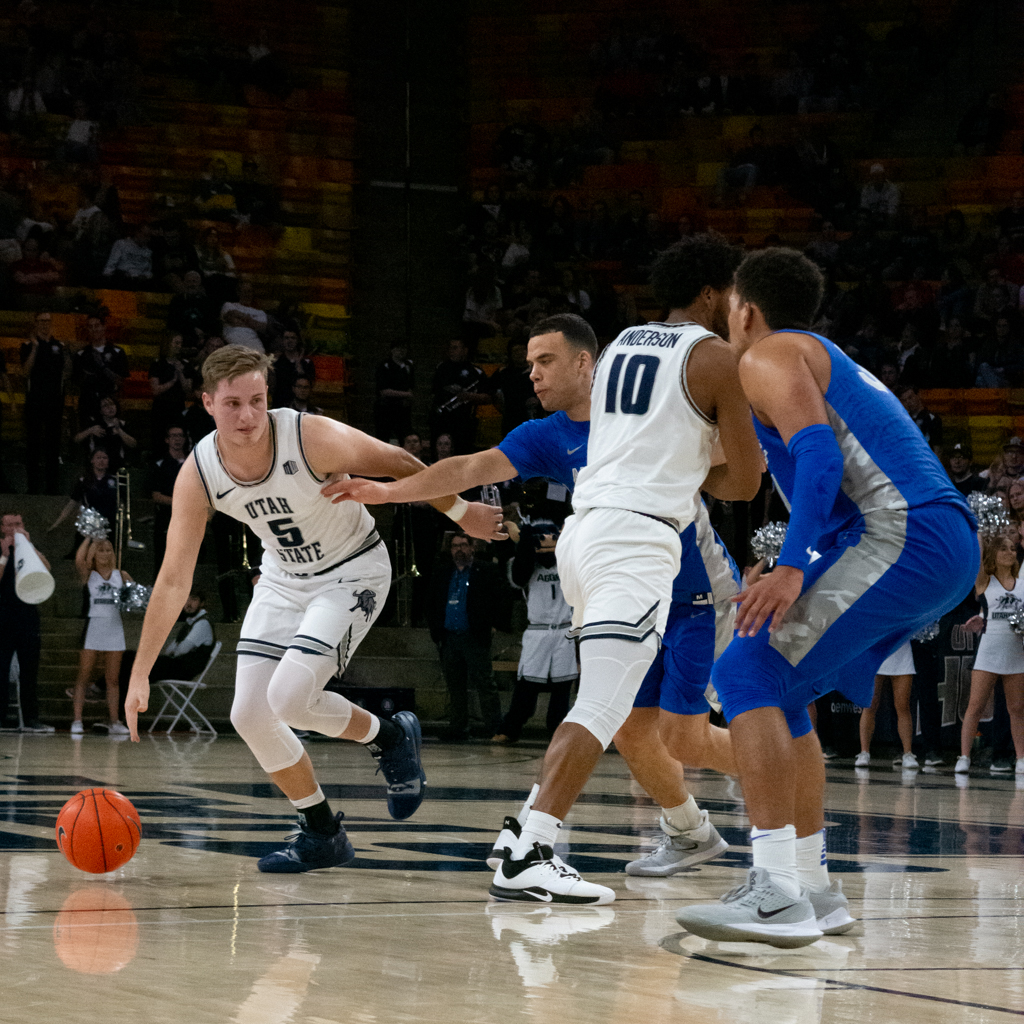Slump busted? Analyzing the Aggies’ shooting
Shooting struggles have been the topic of conversation surrounding the Utah State men’s basketball team for most of the season — but the stats tell a different story.
That’s right, it might not be as bad as Aggie fans may think.
The Aggies are averaging 45.4 percent on field goals and 32.2 from the three-point line. When compared to last year’s averages of 47.1 and 35.5 percent, it shows percentages have gone down. Utah State still has four games left in the regular season and the Mountain West tournament, so these numbers could still increase before this year is inked in the record books. That being said, Utah State has currently scored roughly 680 points less than last year’s team. It’s unlikely they will be able to match or exceed last year’s total by the end of the season.
Bottom line: The Aggies, for the most part, are not shooting exponentially worse than last year. But they are shooting less.
While nothing is certain, there could be a couple potential factors playing into the decrease in shots. For one thing, Utah State started the season on everyone’s watch list. And so did senior guard Sam Merrill. Merrill is the highest scorer for Utah State, averaging 18.4 points per game. This has made him a critical target for opponents to shut down.
“Sam just has so much gravity on offense that sometimes all five guys want to go guard him,” junior guard Abel Porter said.
It seems that having Merrill heavily guarded may have worked out in favor of Utah State’s opponents, at least a little. Last year, Merrill made 228 of 495 attempted field goals. This year he’s made 138 of 315. And while there could be several reasons behind Merrill shooting less, it’s safe to assume him drawing a lot of attention from the defense has something to do with it.
Even so, last year Merrill was averaging 20.9 points per game and was still drawing plenty of attention when he put up all those shots. But last year, defenders had another dangerous Utah State player to worry about every game.
Sophomore center Neemias Queta is the Aggies’ “King of the Key”. Utah State’s big man averages 12.4 points per game and has a field goal percentage of 66 percent. Queta missed the first nine games of the season due to a knee injury. He missed another three games throughout December and the beginning of January dealing with a reaggravation of the injury. As Queta is one of three Aggie players averaging over 10 points per game, his absence was noticed.
Not only did missing Queta down below restrict points in the paint, it also freed up opponents to focus more on other players — including Merrill. But even with Queta back, fans still lament about the shooting struggles plaguing the team. There are a few reasons which may explain why the team doesn’t look as sharp this year.
For starters, Utah State had a slow start to conference play. After winning its first two conference games, the Aggies went on a three-game losing streak. By Jan. 17, the team had a conference record of 3-4 and was ranked seventh in the Mountain West.
Since then, Utah State has improved its conference record to 9-5 and is currently tied for second place with Boise State. But every now and then, the team has an off night — like when the Aggies went 2-19 from three against Boise State on Feb. 8 — and it seems to reinforce the idea that shooting is a severe struggle for this team. And while “severe” might be an exaggeration, certain players have definitely had their challenges with getting the ball into the basket this season.
Porter is one of the biggest examples of this when looking at the stat sheet. The junior’s three-point percentage has plummeted from 40.5 percent last year to 20.9 percent this campaign.
But this might not be any fault of Porter’s. This season the NCAA moved the three point line back to match the international distance of 22-feet and one inch. According to head coach Craig Smith, it’s been a hard adjustment for many players.
“That’s really affected three point shooting all around the country,” Smith said. “I think they thought it was going to space the floor even more, and it’s done the opposite because so many teams are struggling consistently — with the exception of maybe a player or two.”
According to Smith, establishing a rhythm and getting plenty of reps in are key to overcoming scoring slumps.
Despite Porter’s shooting woes, he has managed to increase his average number of points per game this year from 5.5 to 6.4.
Sophomore forward Justin Bean has also seen a major boost in his stat line this year. Bean is currently averaging a double-double and has scored almost three times as many points this season than last.
So even though this season feels drastically different than last year’s out-of-the-shadows, Cinderella season, Utah State isn’t doing too bad in the conference standings. Or in the stat books.
Up Next:
The Aggies will take on Fresno State on Saturday at the Save Mart Center in Fresno, CA. Game time is scheduled for 8 p.m.

